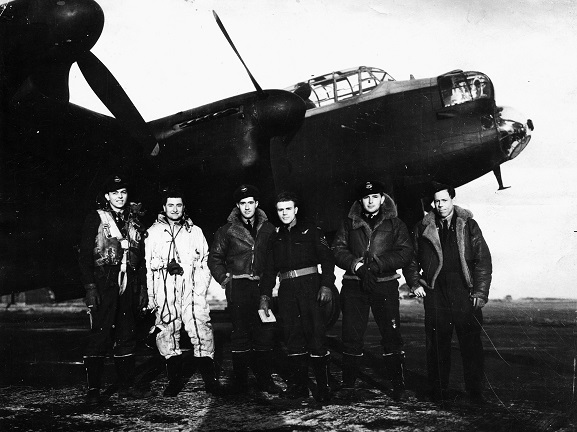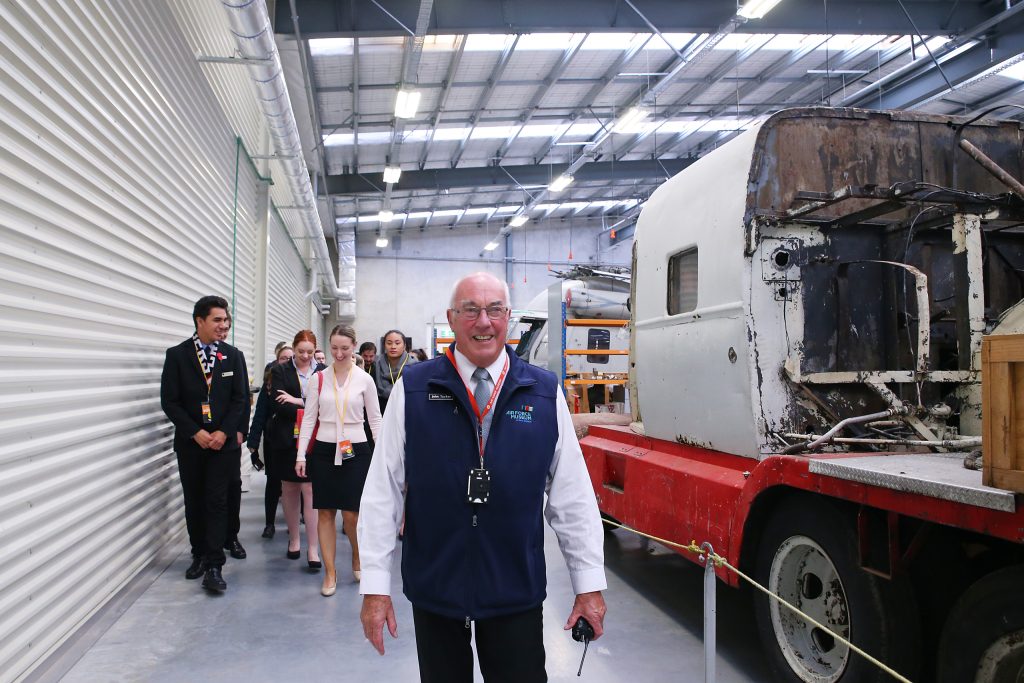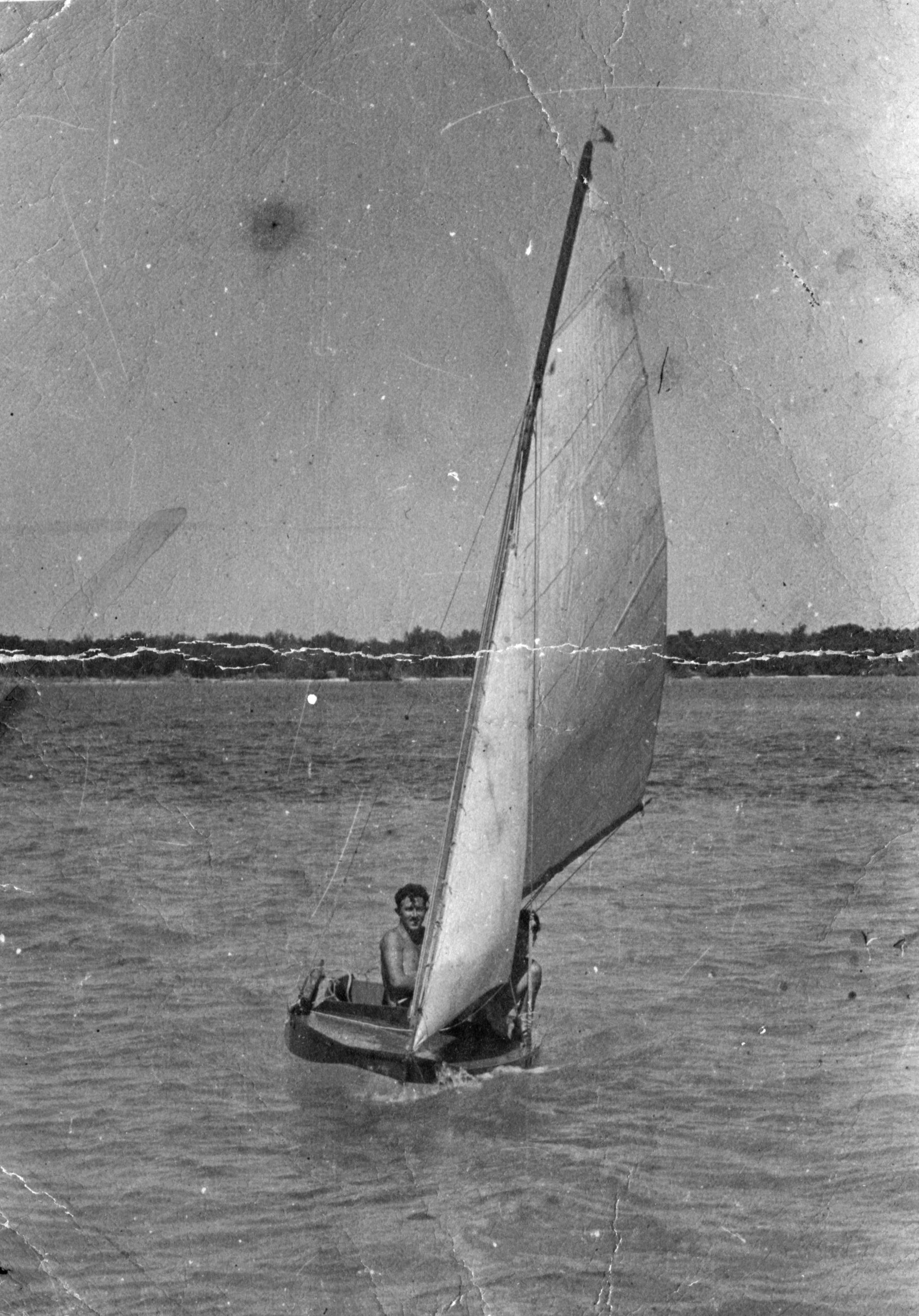Sailing on Palikulo Bay – Robert Highet’s homemade ‘Skimmer’
29 September 2023
Recreation was a key part of life for members of the RNZAF during World War Two. Many sought solace from the rigors of war through theatre, movies and music while some turned to more practical activities such as sports, drawing and crafting intricate ‘trench art’ pieces. Some even went as far as designing and building their own boats. A photograph of one such homemade boat was recently donated to the Museum.
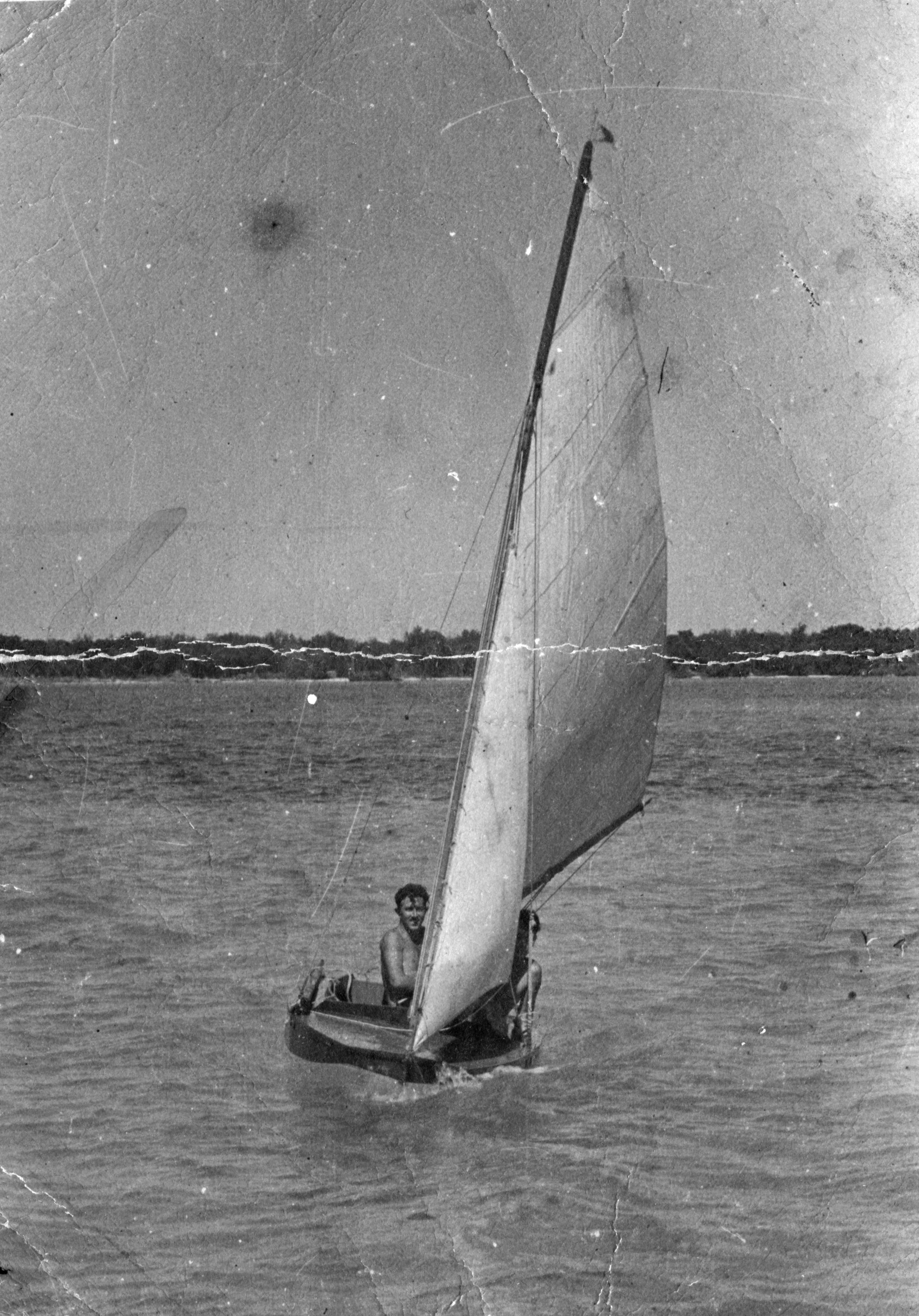
This small boat was built in 1943 by Leading Aircraftman Robert Highet, who referred to it as his ‘Skimmer’, while he was stationed at Palikulo Bay on the island of Espiritu Santo. Robert came from a family with a very strong connection to sailing in New Zealand. His uncle Harry Highet, who also served in the Pacific constructing airfields, was the designer of the famous P-Class, which anyone who has learned to sail in New Zealand will be familiar with. Another relative, Flight Lieutenant Clive Highet, was skipper of the New Zealand yachting team who competed in the Royal Hobart Centenary Regatta in 1938, winning six out of seven starts.
Drawing on his engineering skills, his family’s keen interest in yachting and help from fellow RNZAF member Roy Kendall Robert designed and built this small boat. With typical kiwi resourcefulness they salvaged wood from packing crates to make the frame and skinned it with canvas from a tent which was then sprayed with aircraft dope to tighten and waterproof it. The sail was made from cloth salvaged from a drogue and stitched together by the parachute packers at Palikulo Bay.
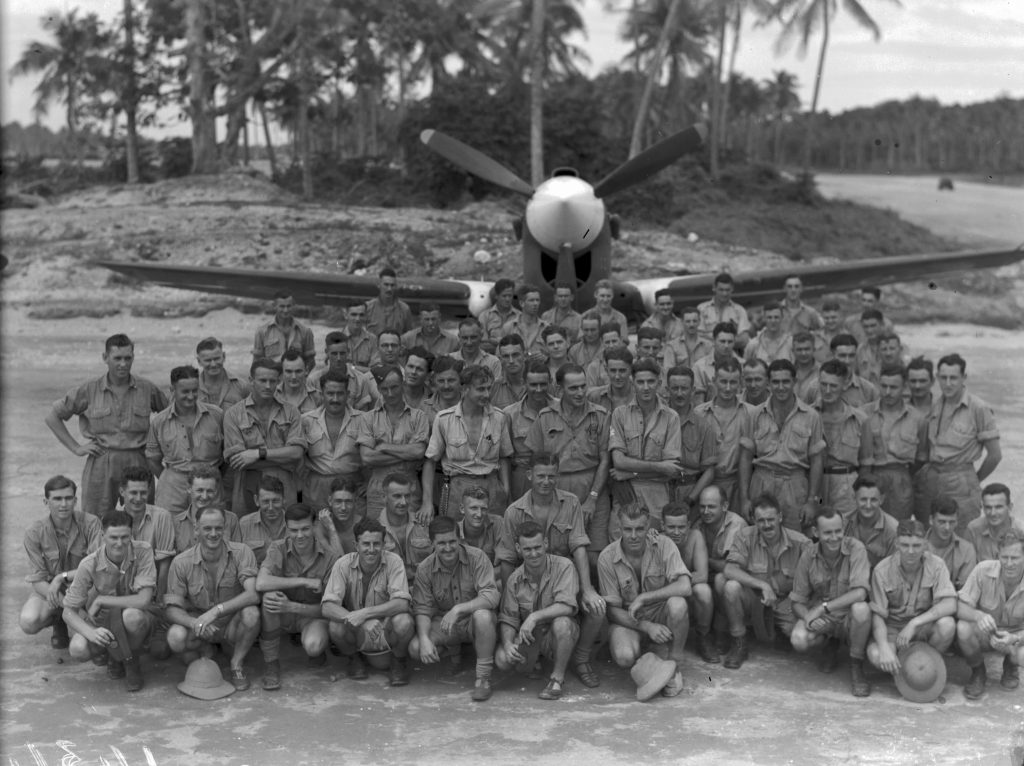
Initially posted to the Pacific as part of No. 14 Squadron RNZAF Robert served as an aircraft engineer. In June 1943 the RNZAF reorganized its squadrons in the Pacific creating specialized aircraft servicing units by separating ground crew and flying personnel. This allowed for flying personnel to be rotated away from forward areas for rest periods while ground crews stayed in one location with all the necessary infrastructure to maintain aircraft in need of repair. As a result of this reorganisation Robert remained on Espiritu Santo as part of No. 2 Fighter Servicing Unit RNZAF while No. 14 Squadron moved to Guadalcanal.
By chance, Clive also served in the Pacific with No. 18 Squadron and spent some time on Espiritu Santo. With both Clive and Robert’s interest in sailing it’s hard to imagine they didn’t enjoy some time on the water together. Sadly, this may have been the last time Clive ever sailed as he was shot down and killed on 27 January 1944.
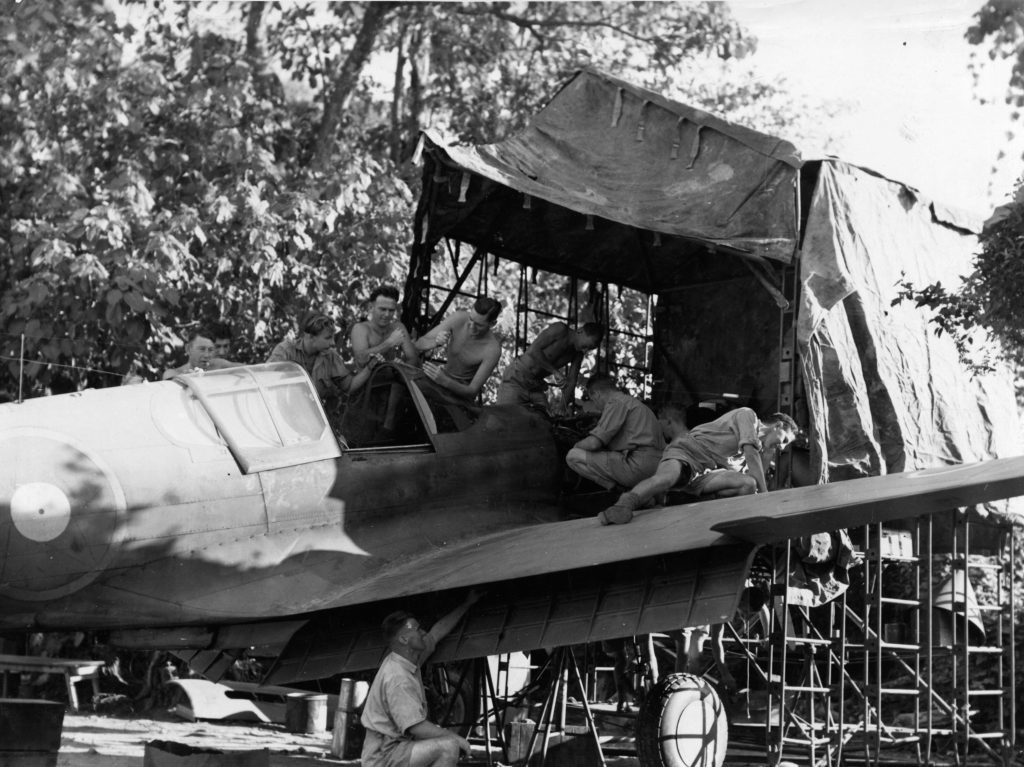
Robert’s time at Palikulo Bay came to an end in November 1943 when his servicing unit was transferred to Guadalcanal. With transport space limited his skimmer was left behind. Its ultimate fate is unknown but it is likely that either American personnel or members of No. 4 Servicing Unit RNZAF, who moved from Guadalcanal to Espiritu Santo, found and continued to use this little boat skimming across the waters of Palikulo Bay.
C. Chambers’ Elephant
5 April 2023
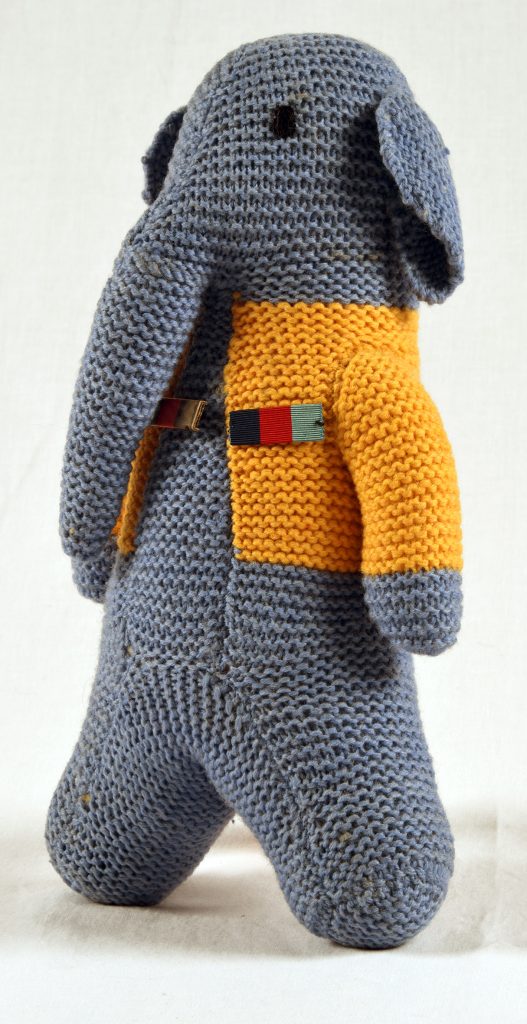
This knitted elephant once belonged to Warrant Officer Charles Chambers. Affectionately referred to as “Jumbo”, this elephant served as the mascot for the crew of No. 51 Squadron RAF Handley-Page Halifax bomber DT568, of which Charles was the captain. The remaining crew consisted of four members of the RAF: Sergeant Arnold Roberts, Sergeant Arthur Stevens, Sergeant Sam Wood, Flying Officer A. Scott, and Flying Officer G. G. Adams, along with one member of the RCAF, Sergeant Melvin Hutchins.
On the night of 12 June 1943, the crew took to their Halifax once again, taking off from their base at RAF Snaith, Yorkshire close to midnight. Due to illness, two members, Adams and Scott, stayed behind, keeping Jumbo on the ground with them. During the return leg of their mission, they were intercepted by night fighters and shot down over the Netherlands by German ace Oberleutnant Hans-Heinz Augenstein. Charles was the only member of the crew to survive the crash but was captured and transported to Stalag Luft VI prisoner of war camp.
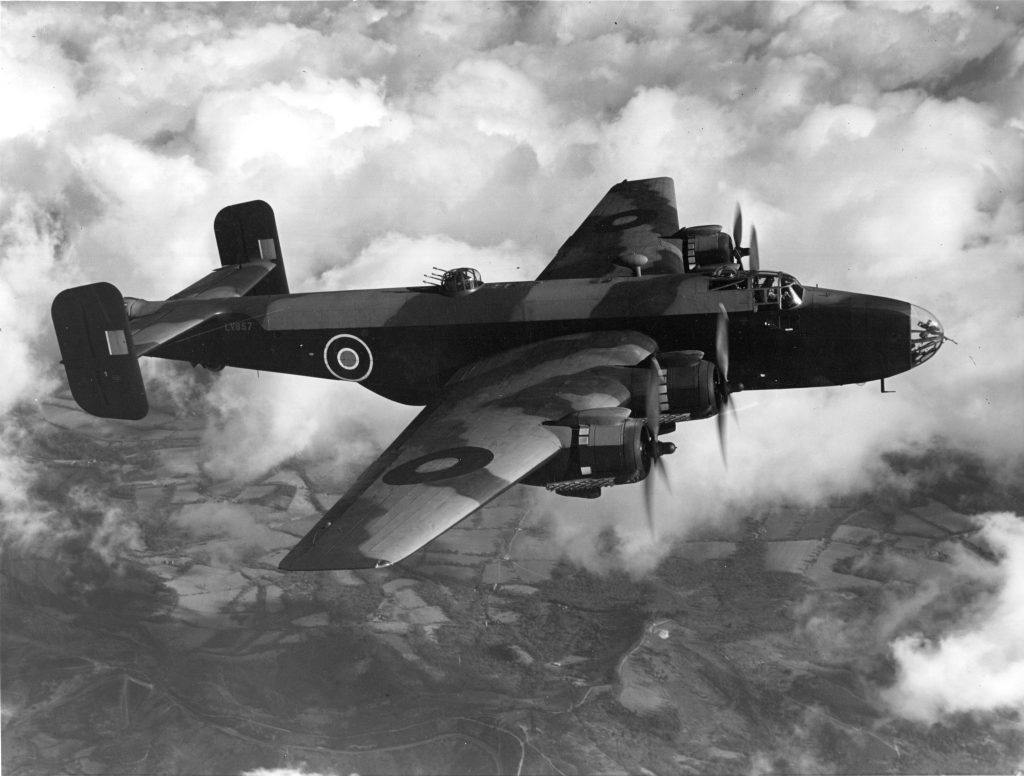
In early 1945, prisoners of war (POWs) from camps along the eastern front were evacuated in an attempt to delay their liberation by advancing Russian forces. Tens of thousands of Allied personnel were force-marched westward through an exceptionally cold winter with temperatures dropping as low as -25 degrees. POWs had endured inadequate food supplies while in captivity and now faced travelling thousands of kilometres with even shorter supplies of food, clothing and equipment, in extremely hazardous conditions. Later referred to as “The Long March”, these forced evacuations resulted in the deaths of thousands of Allied POWs. Unfortunately, Charles was a member of one of these forced marches and, in April 1945, was wounded by a Hawker Typhoon that mistook his column for retreating enemy forces and strafed them. Charles survived his second brush with death and was repatriated to England in late 1945. Upon his return he stayed with Adams, one of the crew who had remained on the ground the night Charles was shot down in 1943. He later returned to New Zealand with his wife Margery, who had served in the Woman’s Auxiliary Air Force.
In the 1990s, Charles and Margery returned to England to visit family and friends. Sadly, Adams had passed away in the 1950s, but Charles did make a visit to Adams’ wife, Elaine. During this visit, Elaine reunited Charles with Jumbo, whom she had kept after her husband’s passing. She entrusted Jumbo to Charles as the last surviving member of Halifax DT568’s crew. The care Jumbo received from Charles, and later his family, is evident in his remarkable condition. With his colours still vibrant and stitching intact, he now resides here at the Air Force Museum alongside our growing collection of mascots, soft toys, and other companions.
John Clifford Packer’s sketches
24 February 2023
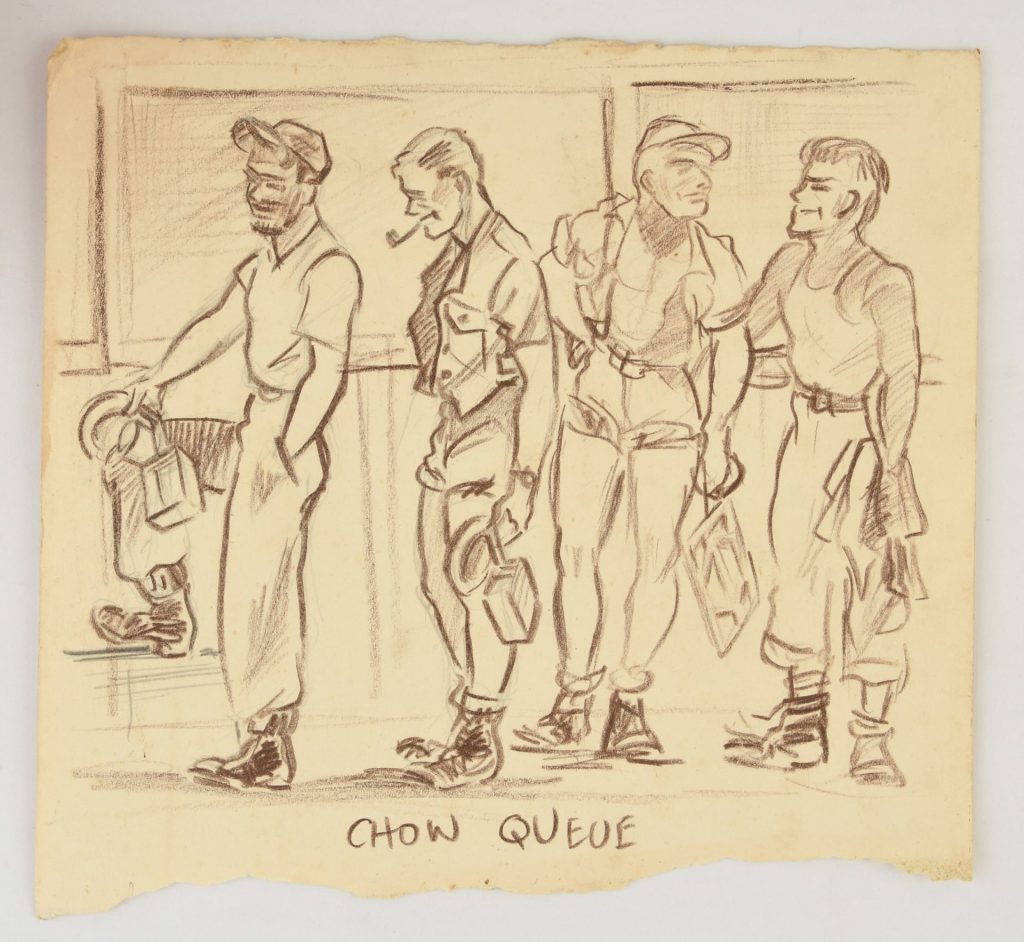
Recently the Museum received a substantial collection of art that was created by Leading Aircraftman John Clifford Packer while serving in the Pacific during World War Two. John joined the RNZAF in August 1942 at the age of 19. Before joining the Air Force, John attended the art school at Wellington Technical College. While studying he developed a talent for sketching, winning an excellence award and placing first in his class for outdoor sketching, lettering, history of crafts, and perspective drawing.
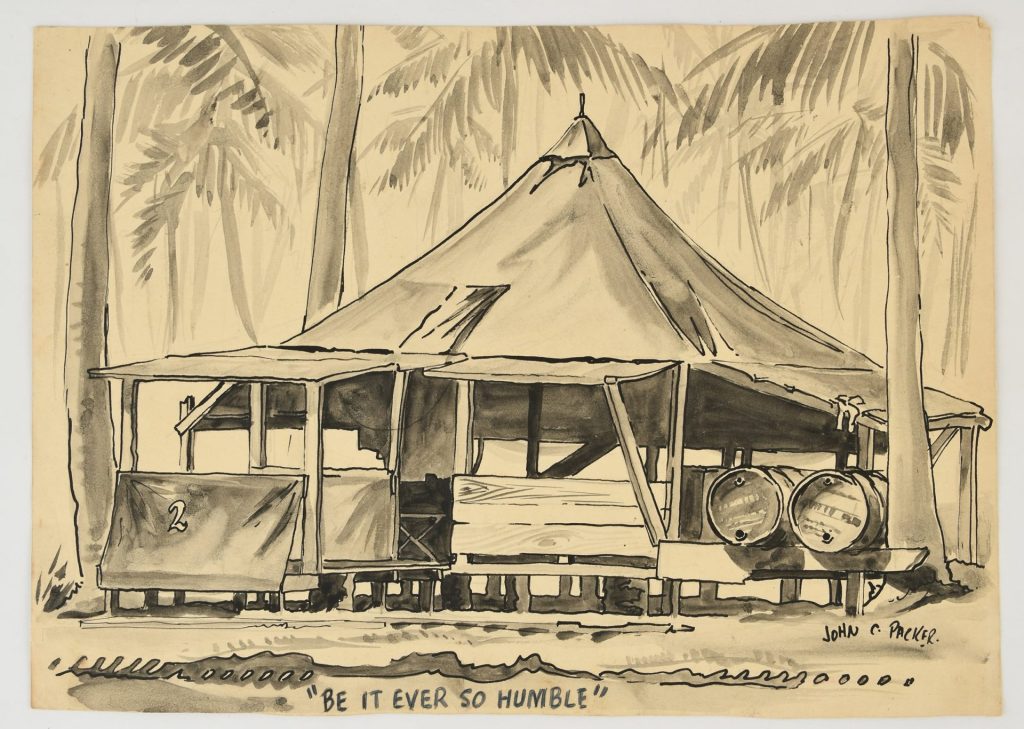
John carried his passion for art into the Pacific where he sketched daily life around him while also providing regular contributions to the many periodicals produced in the islands at the time. His talent was also put to good use by the Air Force with John making several official posters like the one pictured below.
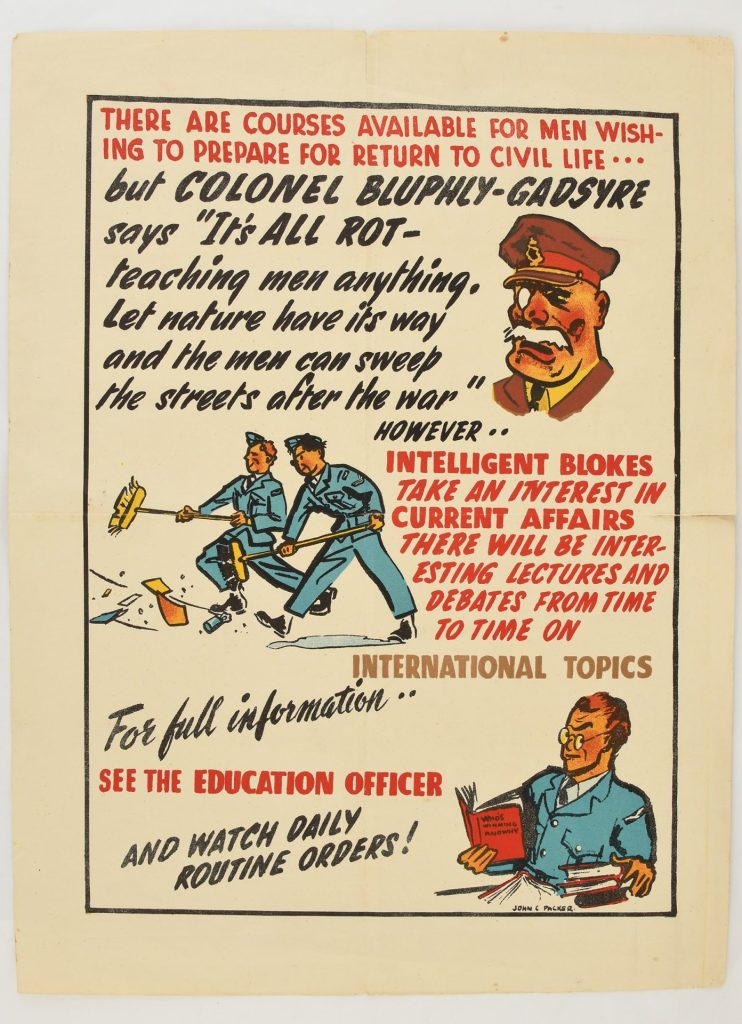
On 1 June 1944, an exhibition titled “Solomon Islands Art Show” was opened in Guadalcanal. This exhibition would later tour New Zealand under the name “Art in the Pacific War Zone”, from December 1944 to March 1945, visiting Wellington, Dunedin, Christchurch, and Auckland. Selected from over 1,500 submissions from Allied personnel, the 272-piece exhibition consisted of paintings, sketches, photographs, and sculptures. The aim of the exhibition was to highlight the conditions surrounding the struggle for the Solomon Islands and offer a glimpse of the experiences of those who served there. Of the 1,500-plus submissions made, three of John’s works were selected, all of which now reside in the Museum’s collection.
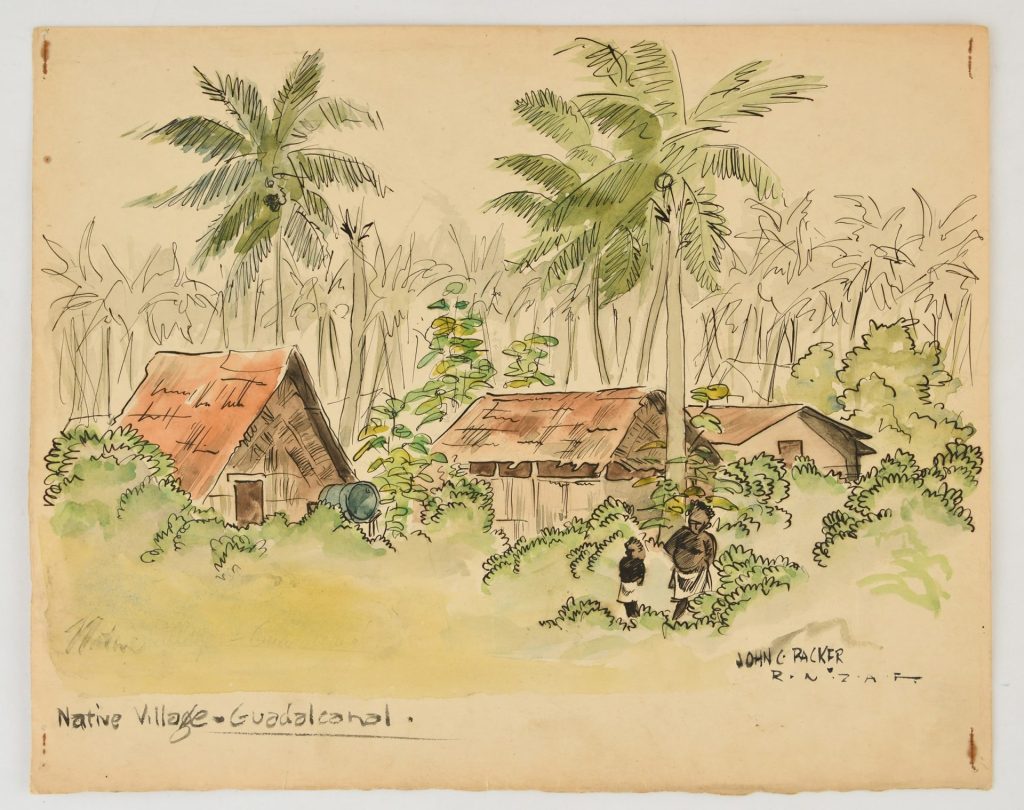
Warrant Officer Ron Brown and his trusty record player
7 September 2022
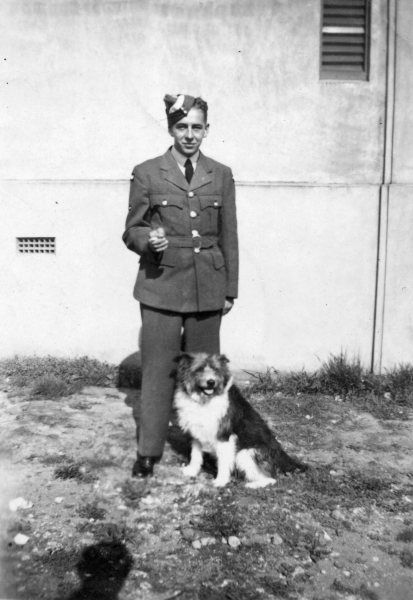
Ronald (Ron) Brown joined the RNZAF in 1941. After some initial pilot training in New Zealand and Canada, he underwent specialist training as a photographic reconnaissance pilot at RAF Benson in England.
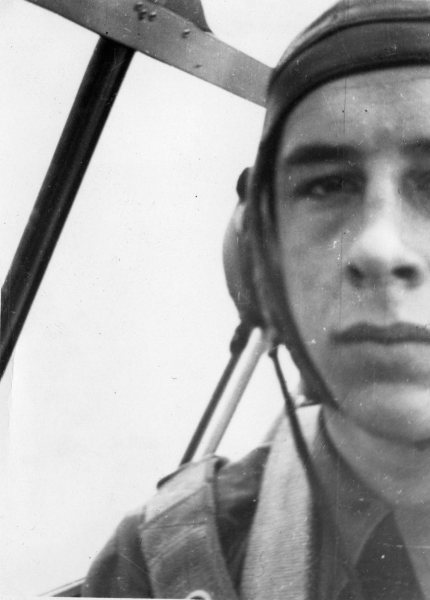
After completing his flying training in May 1943, Ron was posted to No. 680 Squadron RAF based in Egypt. His flying log book details the eight solo flights it took to get from RAF Benson to Cairo with a total flying time of 17 hours. Once in Cairo Ron undertook several non-flying assignments in personnel transit camps before being reassigned in September 1943 to No. 681 (photo reconnaissance) Squadron in India, and later to No. 221 Group Communications Squadron.
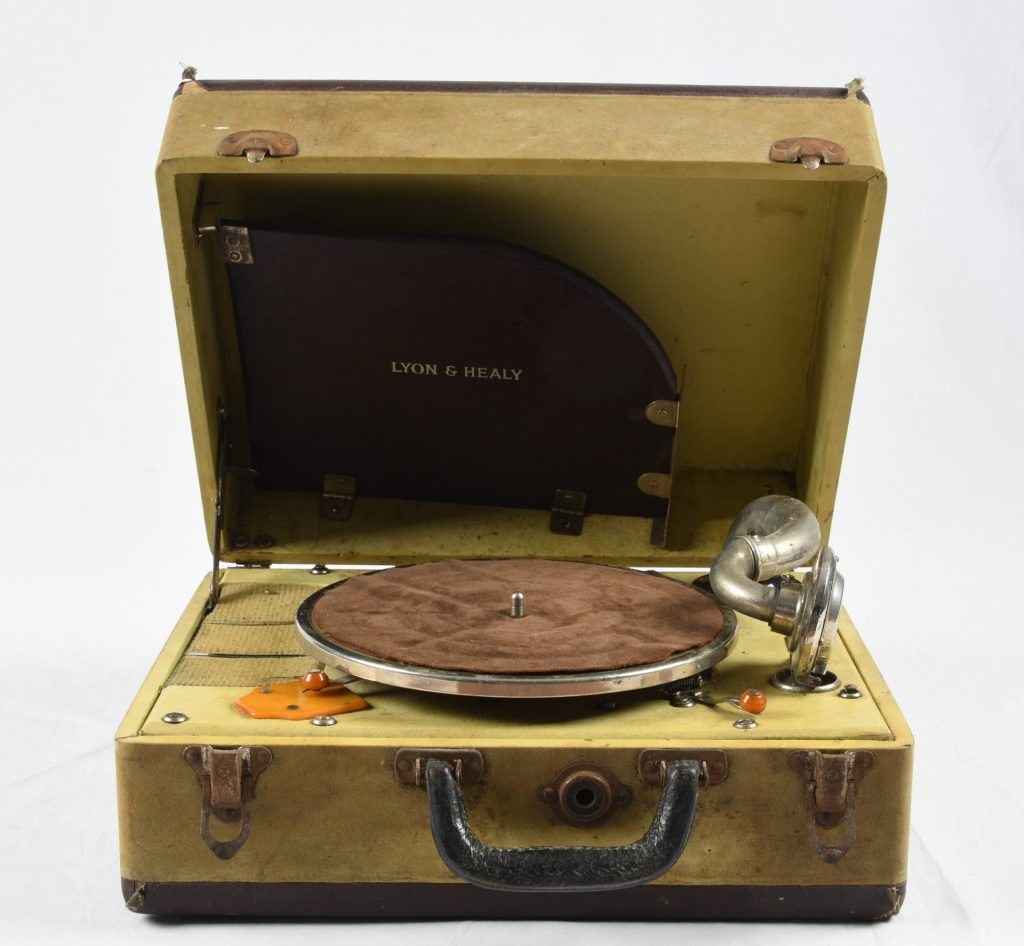
Through all these postings, Ron carried with him his trusty Lyon and Healy portable wind-up record player. As it was manufactured in the United States, it is possible that Ron purchased it either while in transit to, or during his training in Canada.
He was obviously very pleased with the record player as it has its own dedicated page in his photograph album! According to his son, who also had fond memories of the record player from his childhood, Ron took the record player on all his postings and finally back to New Zealand where it continued to be used for many years, before eventually joining our collection at the Air Force Museum of New Zealand.
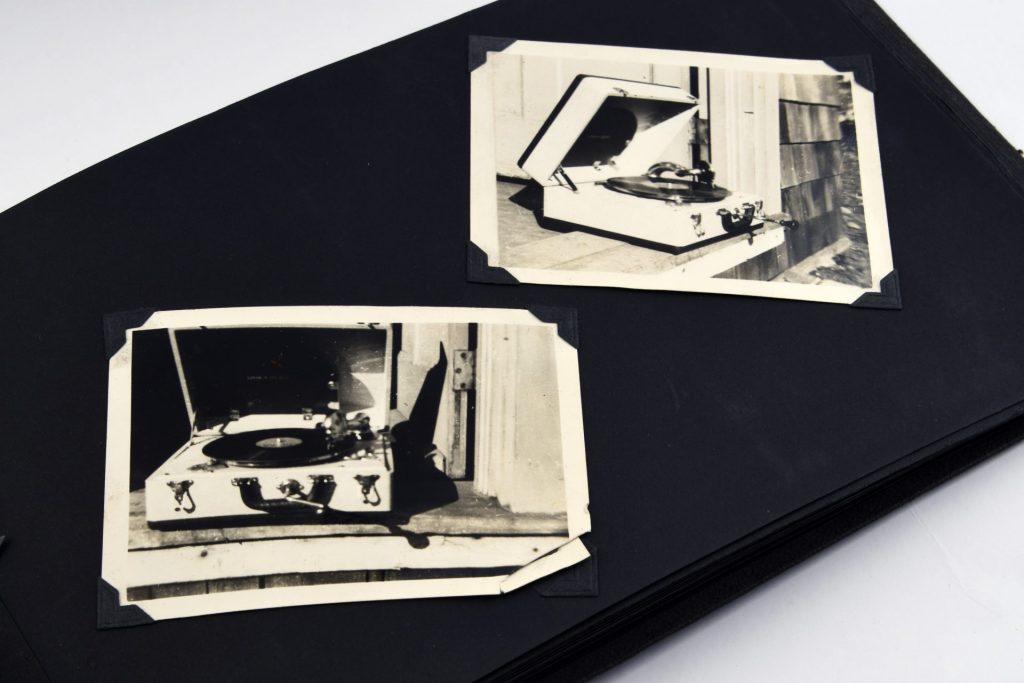
Di Woods’ Service Dress cap
2 August 2022
This recently donated airwoman’s bowler style service dress cap is a unique addition to our collection. It features the gold oak leaf patterned bullion braid reserved for those who attain the rank of Group Captain. What makes this cap special, however, is the fact that it is the only cap that we currently have relating to a female Group Captain. With the relatively small number of women who have, as yet, attained this rank, and our reliance on the generosity of those who have served in the RNZAF and their families to grow the collection, this cap is rare indeed. Needless to say, we were very excited when it arrived at the Museum!
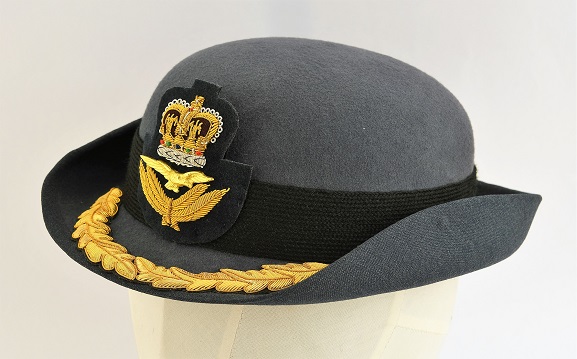
The cap originally belonged to Group Captain Leanne Woon. Leanne had a long career with the RNZAF with many significant postings including International Police Task Force Liaison Officer in Bosnia, Adjutant and later Chief of Operations and Logistics in East Timor, Aide de Camp to the Governor-General, Equerry to the Queen and deployed to the Middle East as part of Operation Troy. In 2006 She was promoted to Group Captain and established the Air Force Women’s Development Forum.
When she retired from the RNZAF, Leanne presented this cap to Wing Commander Chaplain Di Woods, as a token of her faith that Di would also attain the rank of Group Captain. In the late 1980s, Di had seen a news piece on Angie Dickinson, the RNZAF’s first female pilot. Inspired by her story, Di joined the Air Force initially intending to be a pilot, but did not qualify. Having distinguished herself during her initial officer training, she was offered other roles before becoming a supply officer working as flight commander for three different sections at Whenuapai over her 18 months there.
While at Whenuapai Di joined a newly formed Christian group and quickly learned that they were looking for someone to lead it. She began a training course which she thought might help her guide the group but became so interested that she left the Air Force to pursue a three-year theological degree. In 2000 Di returned to the Air Force as a Chaplain and was ultimately appointed Principal Chaplain of the RNZAF. Earlier this year Di transferred to a reservist role and took a position as Dean of Waiapu Cathedral in Napier.
With the recent change to the style of the airwoman’s service dress cap Di wouldn’t be able to wear this one as part of her uniform if she is promoted to Group Captain. Prompted by her move to the active reserve and the change in style, Di decided to donate the cap to the Museum, thereby ensuring the preservation of this unique piece of RNZAF history.
Contemporary collecting with ‘Operation Protect’
15 November 2021
It may surprise some to learn that our collection isn’t all about World War Two! New Zealanders have been involved in military aviation for more than a century. Our mission is to preserve and share their stories, from the past through to the present. To complete this mission, we have items in our collection relating to World War One, World War Two, the post war years, various peacekeeping operations and more recent events.
One of our latest acquisitions is a collection of material relating to something that is very current indeed – the New Zealand Defence Force’s (NZDF) support to the Managed Isolation and Quarantine (MIQ) facilities around Aotearoa/New Zealand in response to the COVID-19 pandemic. This has been codenamed ‘Operation Protect’, and is a duty which many Air Force personnel have been involved in.
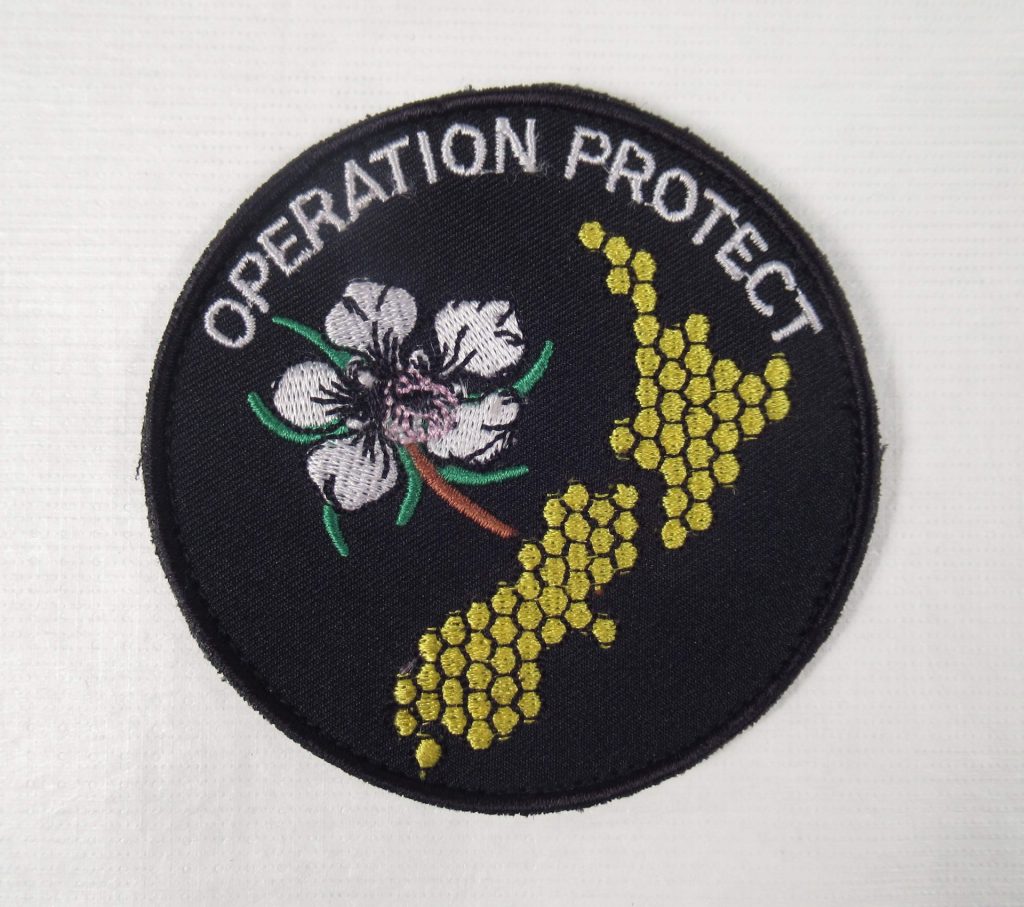
Included in the collection is a patch made for Defence personnel posted to Operation Protect, two examples of the NZDF standard issue face mask, maps indicating MIQ facilities around Aotearoa, policy documents, instructions for personnel, and a rather humorous guide to facial hair that doesn’t impede mask effectiveness. It demonstrates the wide array of material we’re interested in, it’s not all aircraft and war stories!
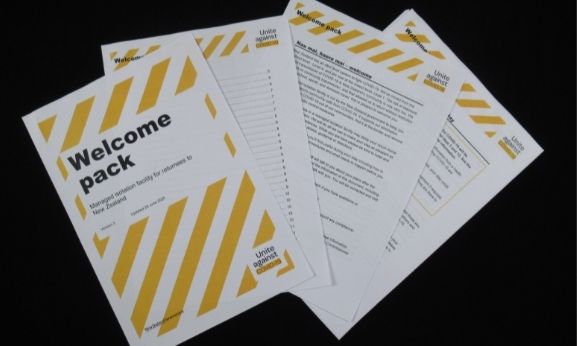
In the museum world, the acquisition of material relating to current events is called ‘contemporary collecting’. This concept may not be the first thing that comes to mind when people think of a museum, which is often full of ‘old stuff’. There are, however, certain benefits to engaging in contemporary collecting. Usually there is a lag in collecting, with people offering items to the Museum many years after their service (or that of a relative), when they start to think about downsizing or clearing out space at home.
The trouble is, by the time they come to us, the condition of the items may have deteriorated, other things may have been lost, or important details forgotten. There is also a certain degree of randomness to this approach. For something to end up at a museum, it first has to survive. Multiple factors influence the chances of something surviving and the more time that passes, the smaller that chance becomes. Contemporary collecting allows us to create a more complete, inclusive and interesting collection by giving us the opportunity to acquire material in a more targeted, proactive way, removing some of the randomness.

As mentioned above, one of the main purposes of our collection is to tell stories. Collecting items from contemporary events allows us to preserve these stories and the physical integrity of the items that tell them. We are always on the lookout for opportunities to collect contemporary material, as it offers a chance to preserve the story of the Air Force as it is today, which of course will become tomorrow’s history.
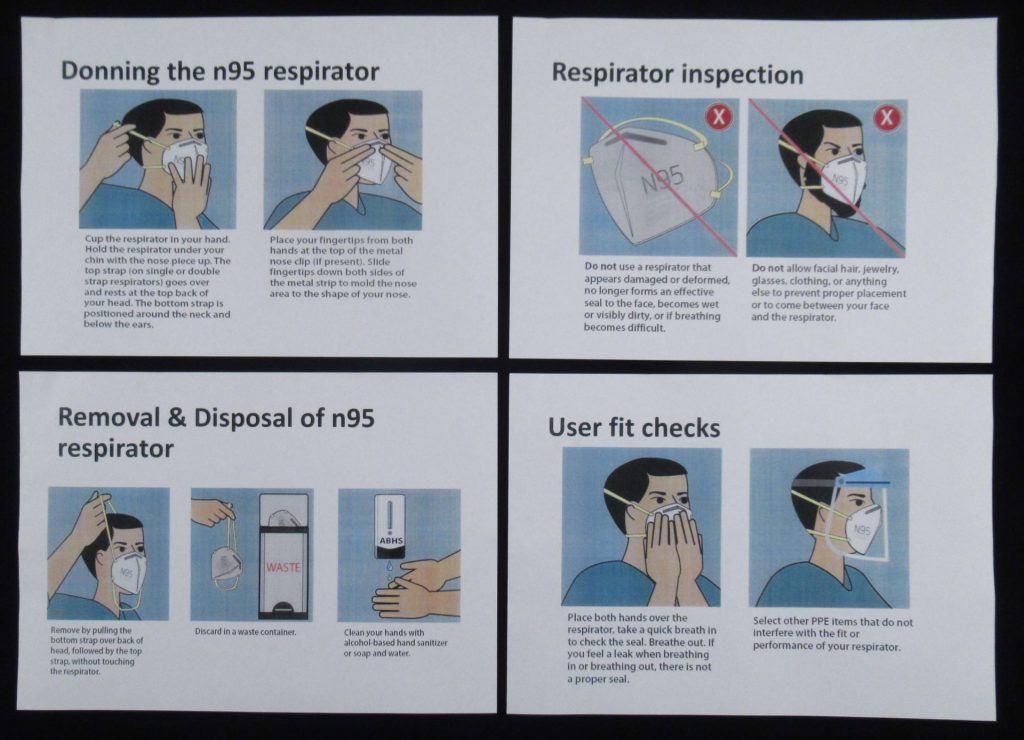
Squadron Leader Maurice Robinson’s United Nations Flag
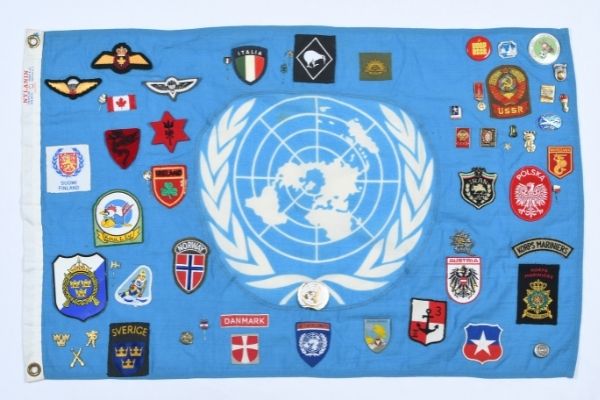
16 July 2021
In 1978 the United Nations established the United Nations Interim Force in Lebanon (UNIFIL), a peacekeeping mission aimed to oversee the withdrawal of Israeli forces which had occupied Southern Lebanon in support of the pro-Israel, Maronite forces fighting Palestinian and Pan-Arabist militia during the Lebanese Civil War. RNZAF Squadron Leader Maurice Robinson was assigned to UNIFIL as an observer based at Marwahin, a small town along the Lebanon-Israel border. While there, Maurice collected the numerous badges and patches that decorate this UN flag, recently donated to our collection. He acquired them from UNIFIL members from all over the world, including the former Soviet Union, with some badges featuring the mascot of the controversial 1980 Summer Olympics in Moscow, Misha the Bear.

Tensions between the UN observers and pro-Israel militia groups were high with numerous incidents of armed militiamen raiding Maurice’s observation post, stealing both UN supplies and personal belongings. These raids escalated on 20 May 1980, when Maurice was abducted for allegedly making derogatory remarks about senior militia leaders and the involvement of non-Lebanese groups in Lebanese politics; allegations that Maurice and three other officers at his observation post vehemently denied. His abduction led to a brief standoff between the unarmed UN observers and the militia when another officer from his observation post followed the militiamen back to where they were holding Maurice and demanded his immediate release. The militia leader and the officer had a short scuffle, grappling over a weapon, which the militia leader had fired into the air several times. He threw a single punch at the UN officer striking him on the face, effectively ending the fight. The militia leader then turned on Maurice, brandishing his weapon and grabbing him by the throat before releasing him to the other UN officer.
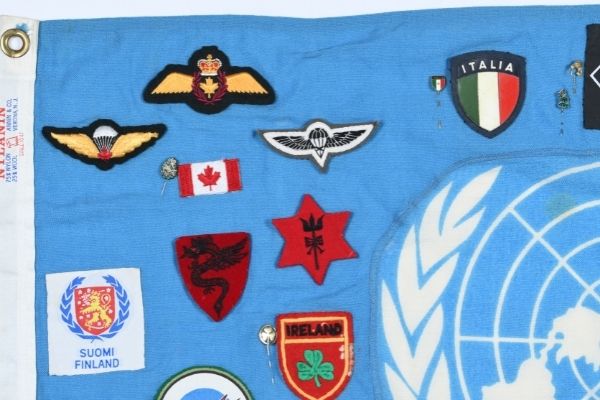
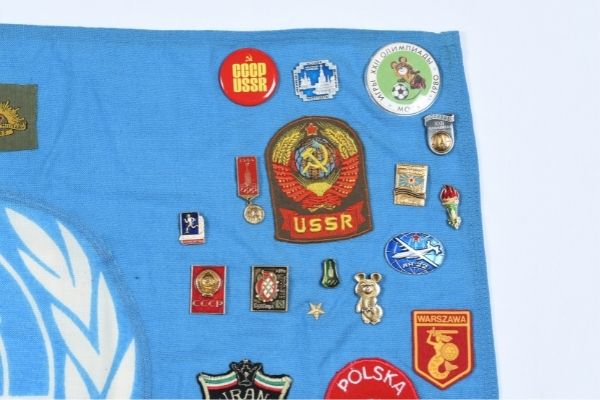
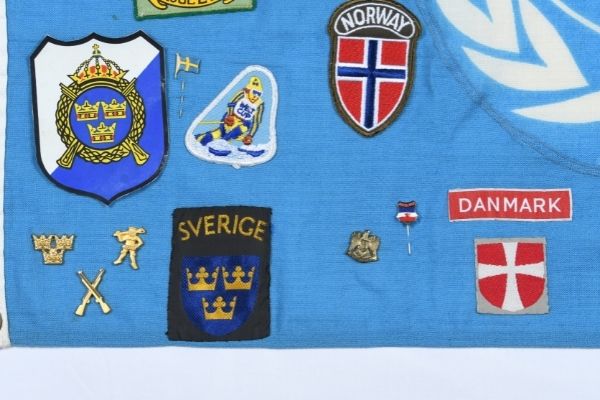
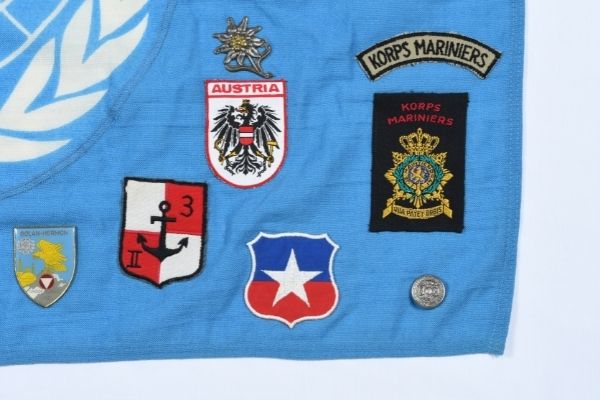
In his after-action report, Maurice describes the event as a deliberate attempt to inflame tensions between pro-Israel forces and the UN observers, stating it “gave me the impression of being stage-managed” and that he believed the whole incident was designed to intimidate more than anything else. He suspected the gunfire was timed to coincide with radio transmissions from a nearby UN vehicle, giving those receiving the transmission a false sense of danger and that the violence directed to him and other UN personnel was half-hearted at best. Maurice’s ability to stay calm, collected and professional during the numerous raids on his observation post and his abduction helped deescalate these potentially dangerous situations and avoid a similar situation that occurred just a month earlier where two members of UNIFIL had been killed.
Albert Marsden – Political Commentator and Aircraft Engineer
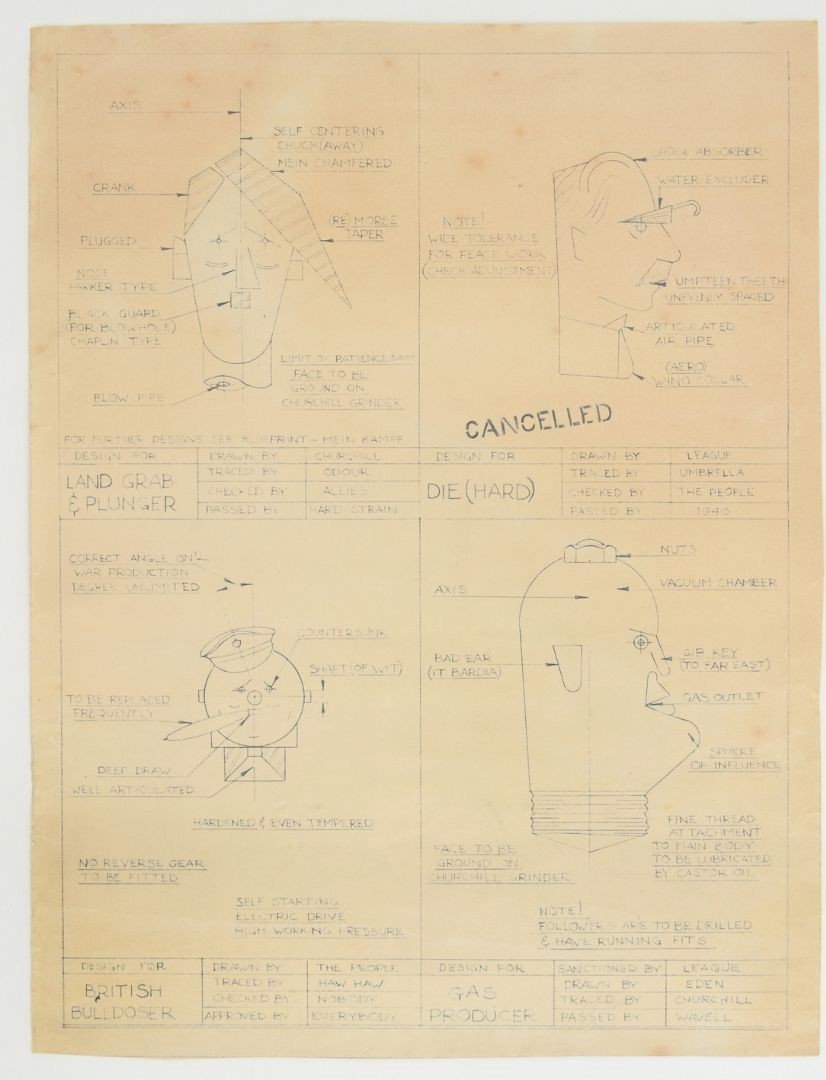
11 June 2021
This engineering-inspired cartoon which recently came into our collection, was drawn by Albert Marsden, and shows his opinions of the political situation during the early years of World War Two. It features some witty commentary and caricatures of four major political leaders of the time in a format that Albert was very familiar with through his career as an aircraft inspector working for the Aeronautical Inspection Directorate. Depicted are Winston Churchill, Neville Chamberlain, Benito Mussolini and Adolf Hitler. Churchill features his often-present cigar, with a note that it is “to be replaced frequently” and stating “no reverse gear to be fitted” referring to Churchill’s well-known determination.
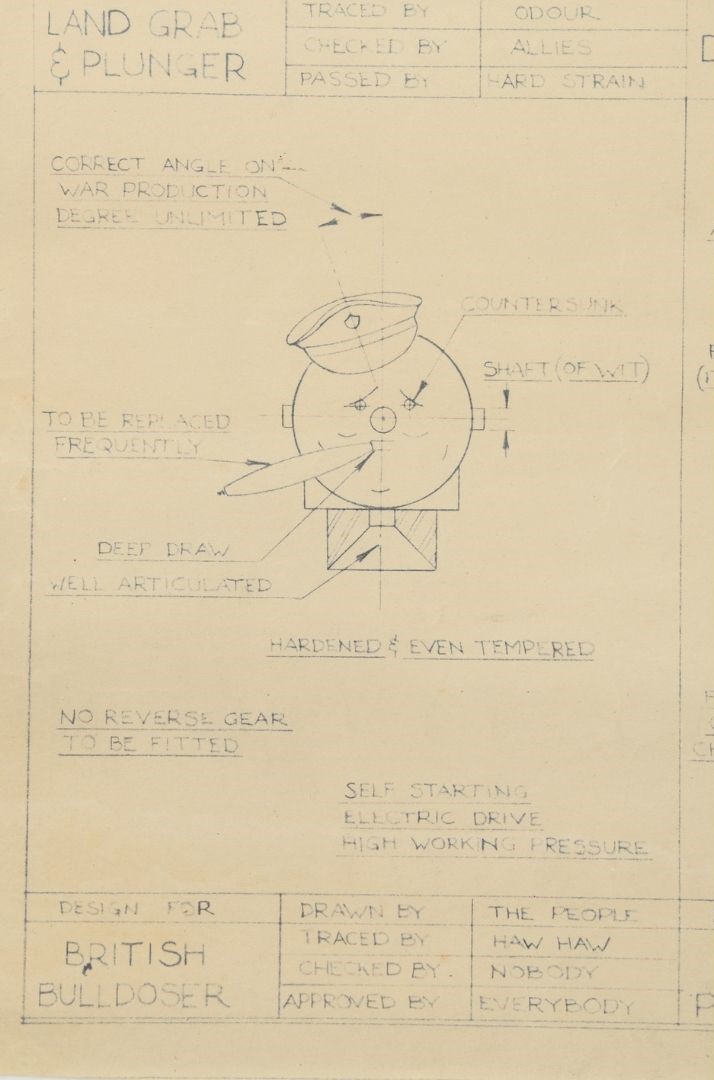
Churchill’s predecessor as Prime Minister, Neville Chamberlain is annotated “note wide tolerance for peace work (check adjustment)” a reference to his attempts at securing peace in Europe during the 1930s. He also has “cancelled” written across the bottom of his picture noting Chamberlain’s resignation as Prime Minister in 1940.
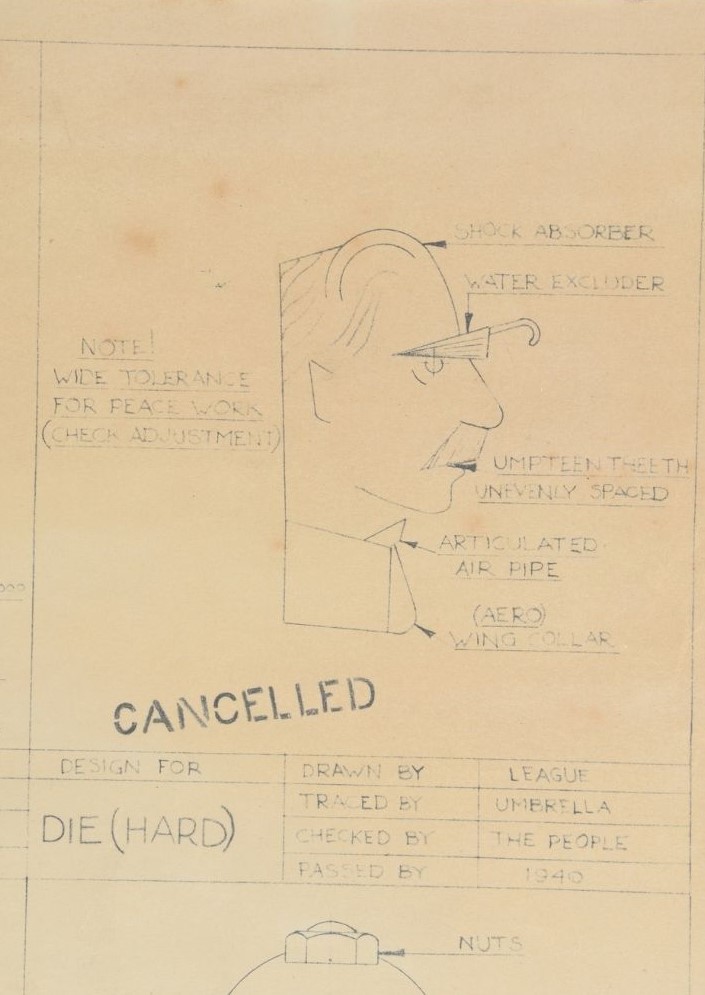
Mussolini is depicted with Marsden’s unflattering appraisal of the Italian dictator, labelling his head as a “vacuum chamber” and his mouth as a “gas outlet”. His ear is labelled “bad ear (it Bardia)”, a mention of the first Allied military operation of the Western Desert campaign, the Battle of Bardia.
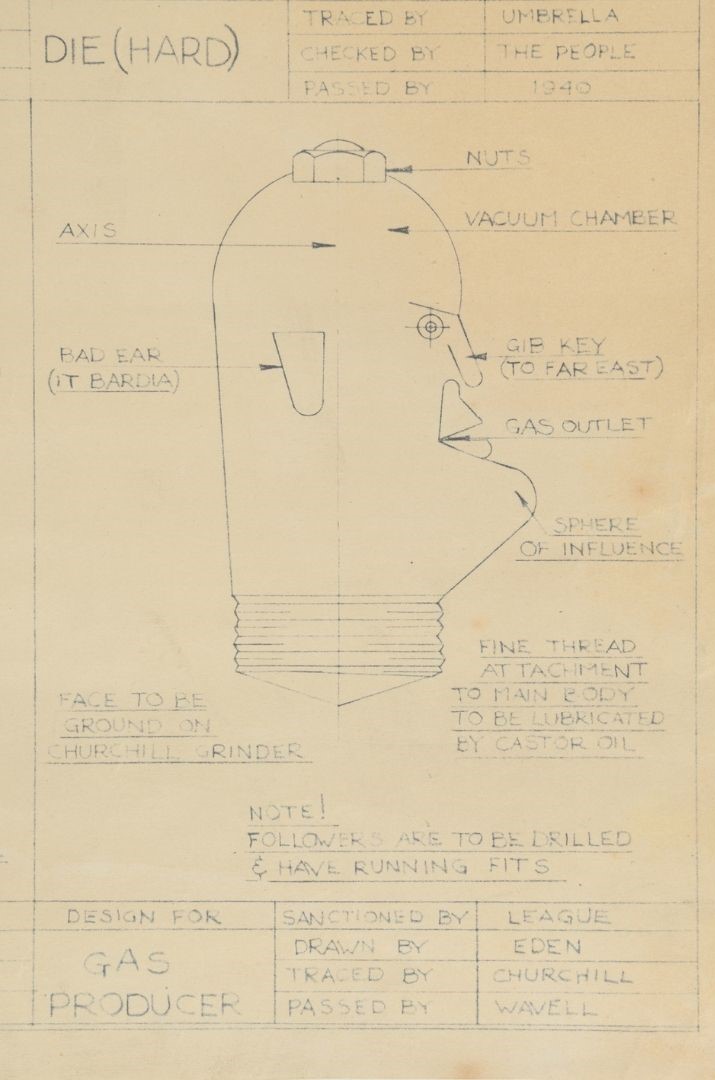
Hitler receives similar treatment with his ears marked “plugged” and his head “crank”. He describes Hitler’s distinctive moustache as a “black guard (for blowhole) chaplain type”. He also notes that Hitler can be “traced by odor”. Marsden suggests that each of the Axis leaders are “to be ground on Churchill grinder”.
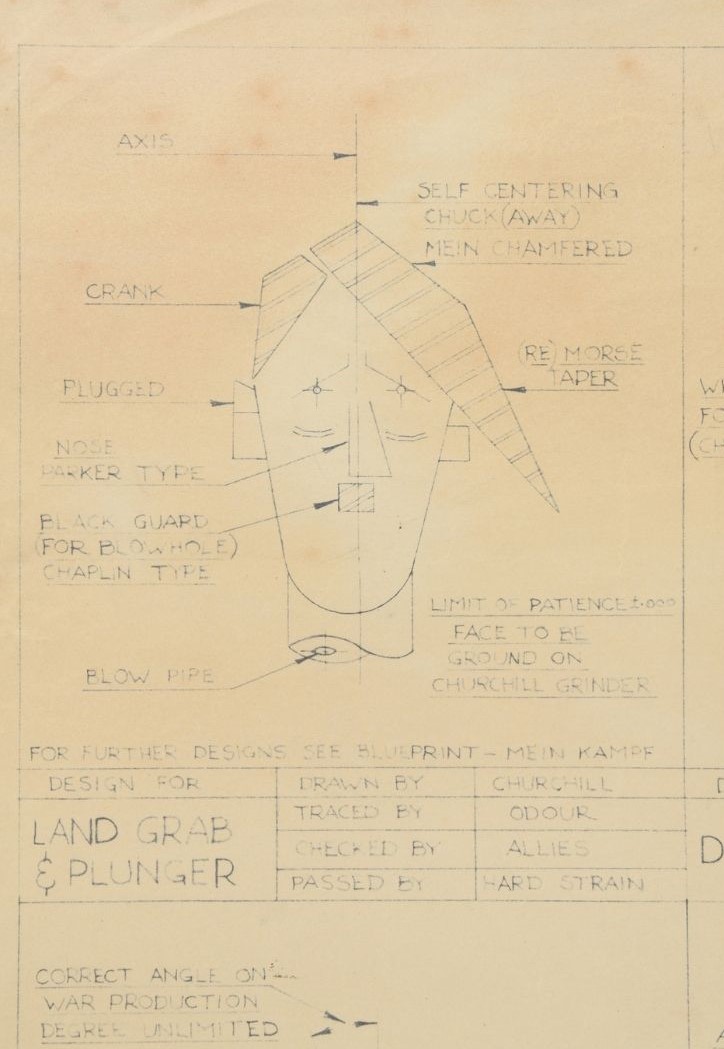
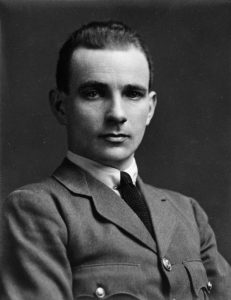
Albert was born on 26 March 1888 in Christchurch where he later trained as a cabinet maker. In 1913 he travelled to England, working his passage as the ship’s carpenter aboard the Waimana, to further his studies at the London Polytechnic.
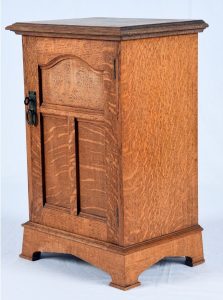
His aviation career started when he joined Vickers Limited as an aircraft engineer. He worked there building aircraft until he got a job as Chief Aircraft Inspector for the Aeronautical Inspection Directorate, inspecting all aircraft that were produced in Scotland for the Royal Flying Corps and later Royal Air Force. In 1939 he was sent to Canada as Chief Inspector of all aircraft being produced under contract for the RAF, later his responsibilities were expanded to include overseeing the aircraft production happening in the United States.
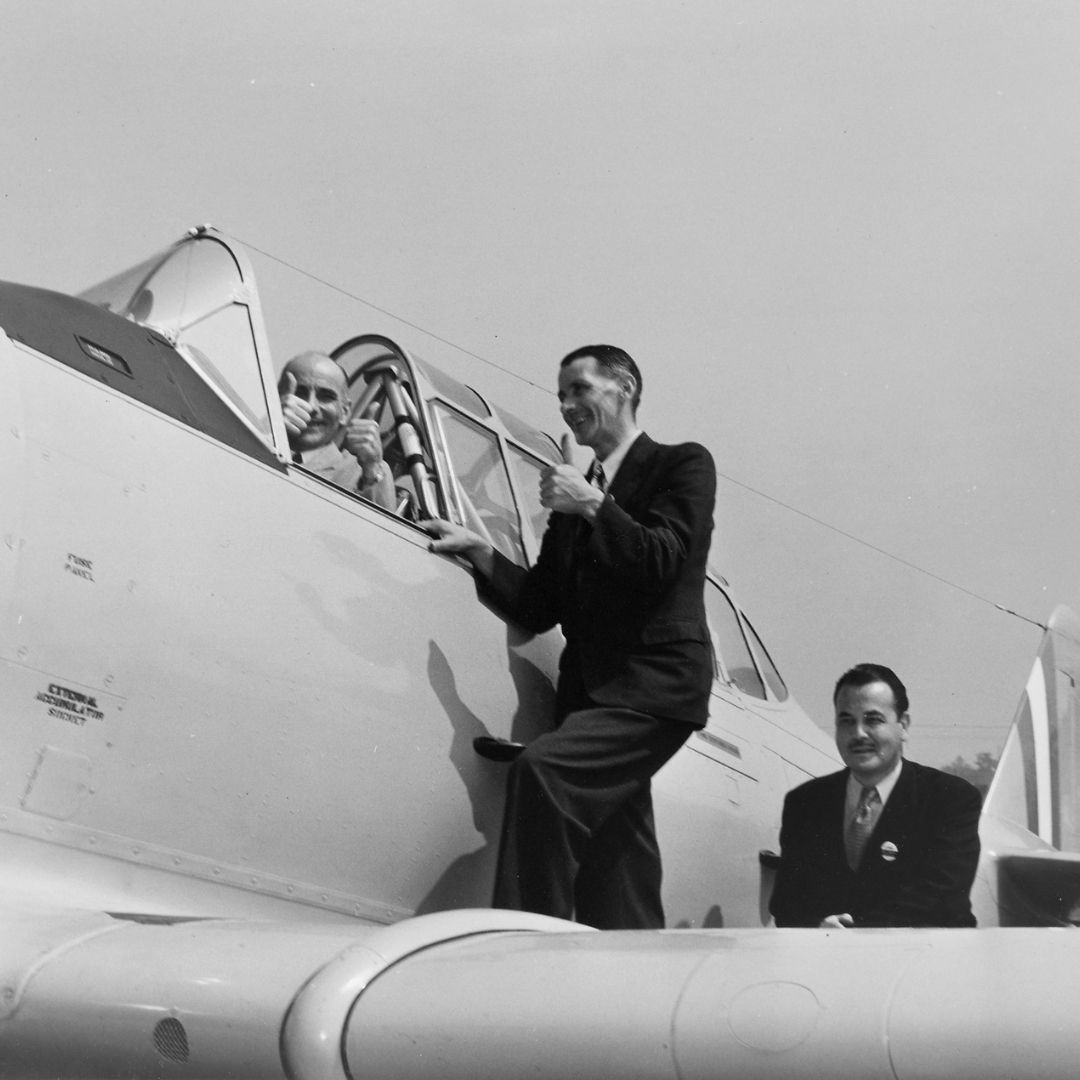
During the same year he was also awarded the honorary title of Air Commodore in recognition of his services to the RAF. He remained in Canada and the United States overseeing aircraft production throughout World War Two, returning to England in 1946 when he was appointed to the Order of the British Empire for his services to aviation. Albert retired from the Aeronautical Inspection Directorate in 1948, returning home to New Zealand with his wife Henrietta later in 1950. Albert passed away in June 1972 at the age of 84.
Rona McIndoe’s Radar Tokens
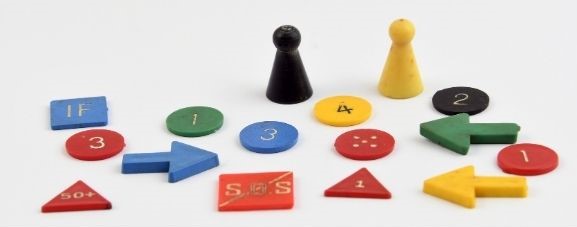
27 April 2021
Recently donated to the museum, these plastic counters may look like they are part of a board game, but they are actually part of the complex radar filtering system developed during World War Two. They were used by Sergeant (W) Ethel Rona McIndoe – known as Rona – in her role as a radar Filterer here in New Zealand. Working as part of a wider team, Rona’s job was to receive information from radar stations and observers as they detected aircraft, collating the information into its essential parts, namely direction, altitude, number and type of aircraft.
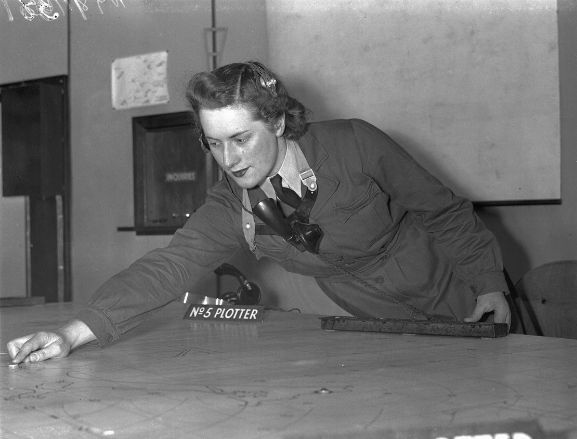
This information was plotted onto a map in the form of tracks comprised of counters like these that relate to specific details and was essential for ensuring information was accurate before it was acted upon. Once identification was confirmed, the aircraft could be designated friendly or hostile and the information then relayed to relevant Group and Sector command Operations Rooms. These tracks provided an everchanging picture of what was happening in the air. They also allowed operators to predict flight paths and potential targets of enemy raids, scrambling interceptions with increased accuracy and speed. Although this system was rarely used against an enemy in New Zealand it was used extensively, to decisive effect, in Europe during famous air battles like the Battle of Britain.
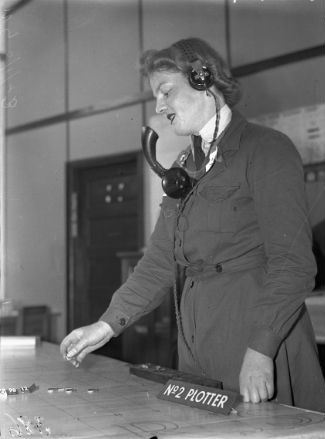
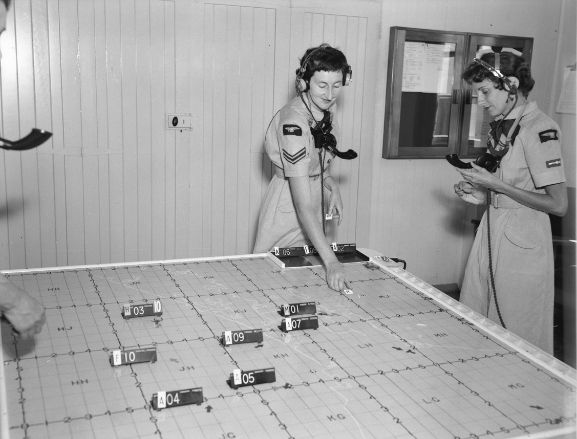
Rona joined the WAAF in March 1943 training as a Radar Plotter, serving at Wellington and Auckland throughout World War Two. She was discharged from the Air Force in 1946 but reenlisted as a reservist on the 28th of August 1954. Continuing in her Radar Plotter trade, she spent much of her time as a reservist training at the Chain Overseas Low Radar Unit 4 located at Piha, west of Auckland, with other territorial units and people undertaking their Compulsory Military Service. The station had been mothballed after World War Two but reactivated as a training facility in 1953, tracking RNZAF aircraft as they flew out of Whenuapai and assisting with navigation exercises by guiding them from the ground.
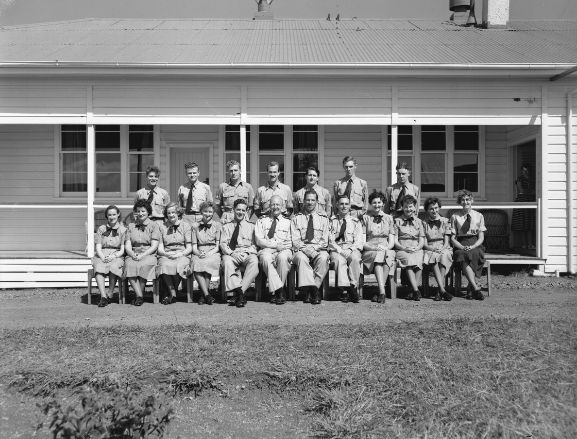
Rona left the Air Force on the 27th August 1957 upon completing her term of service. She was an active member of the Ex WAAF Association, attending many reunions over the years and was always proud of her service with the Air Force. In December 2019 Rona celebrated her 100th birthday, receiving several letters and cards, notably from the Queen, Prime Minister Jacinda Ardern, Governor-General Patsy Reddy, Auckland Mayor Phil Goff and Chief of Air Force Air Vice-Marshal Andrew Clark. Sadly, Rona passed away shortly after this celebration on the 25th of March 2020 at the age of 100 years and 3 months.
Wayne Molloy’s recruitment booklet
5 March 2021
Often it is something small that inspires us to great undertakings. Such was the case with this RNZAF “Aircraft Apprentice and Boy Entrants” recruitment information booklet recently donated to our collection.
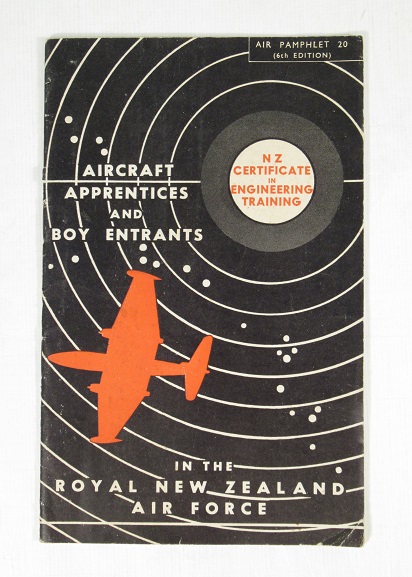
Wayne “Blue” Molloy came across the booklet in 1965. Inspired, he joined the RNZAF as an apprentice instrument fitter and completed two and a half years of trade training at RAAF Wagga Wagga in Australia before returning to New Zealand. The large stack of binders seen here contain his precis and technical notes built up over his time at Wagga Wagga and kept as reference material while he was an instructor at No. 2 Technical Training School RNZAF. Wayne left the Air Force, at the rank of Warrant Officer in 1992, the booklet having inspired a career spanning 27 years!
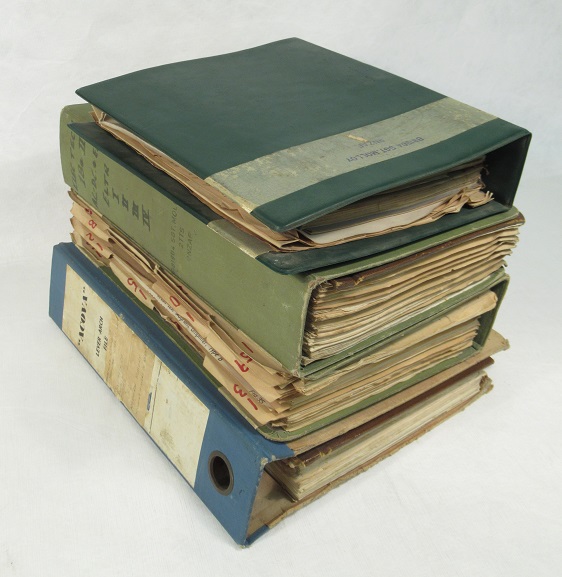
Gordon Woodroofe’s escape clothing
3 November 2020
Among the recent new additions to the Museum’s collection is this set of clothing, belonging to Warrant Officer Gordon Woodroofe, the only New Zealand airman to successfully escape from a German Prisoner of War (POW) camp during World War Two.
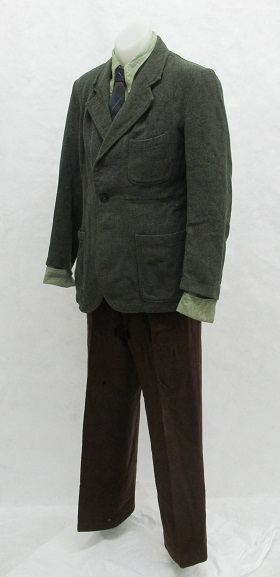
Warrant Officer Gordon Woodroofe was captured after his Wellington bomber ditched in the North Sea on 11-12 September 1941.
While imprisoned in Stalag Luft III in July 1942, Gordon swapped identities with an Australian soldier. His new identity as an army private meant that he was eligible for a kommando (working party), which presented better escape opportunities than remaining in camp. He was transferred to Stalag VIIIB and in May 1943, escaped from a kommando near the Germany-Czechoslovakia border. He succeeded in walking and cycling all the way to the Austrian alps before being recaptured.
Undeterred by this failure, on 17 August 1944 Gordon escaped from another kommando, with German money, forged documents and civilian clothing, which he had acquired in exchange for cigarettes. Disguised as a free French foreign worker, Gordon travelled by train all the way through northeast Germany to the Baltic port of Wismar, his ability to speak German helping him along. In Wismar he was assisted by a group of Frenchmen to board a Swedish coal vessel. The sailors agreed to hide him under the cabin floor, and when the Gestapo came to do their routine inspection, they diverted their attention by bartering with them. When the ship docked in neutral Sweden, Gordon made his way to the nearest police station, and after receiving a brand new passport, was conducted to the British Consulate in Stockholm. He realised, with an “intense emotional surge”, that he was free at last, and was flown back to Scotland on 8 September 1944.
Gordon Woodroofe’s escape was an incredible accomplishment, given that only 33 others, from a total of 10,000 RAF POWs, managed to achieve a ‘home run’. He later received the Military Medal for his efforts.
You can read all about Gordon’s daring escape in his autobiography, GeTaWay. Now out of print, there are limited numbers available for purchase from the Museum Shop.
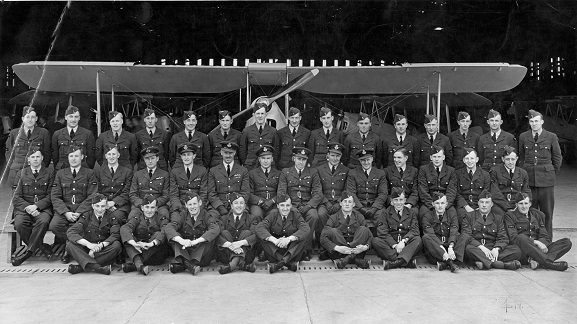
Frank Cardwell collection
29 September 2020
We were thrilled to receive recently the personal collection of Pilot Officer Frank Cardwell, who served as a Navigator with RAF Bomber Command in World War Two. The collection, which was generously donated by his family, includes uniform items and insignia, personal effects, service documents, souvenirs, personal papers and photographs.
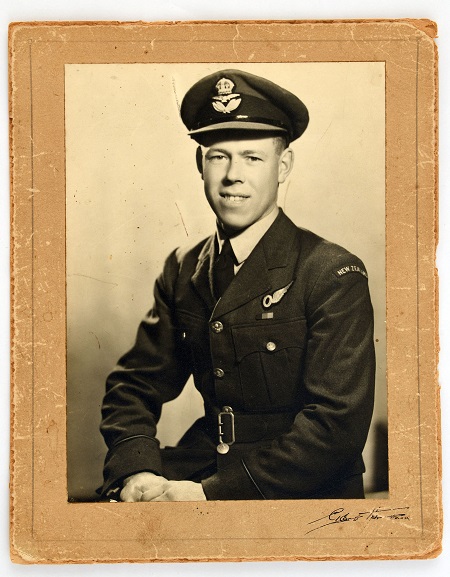
Pilot Officer Frank Cardwell served as a Navigator with RAF Bomber Command in World War Two. His first operational posting in July 1944 was with No. 44 (Rhodesia) Squadron, flying Lancasters. In November 1944 he joined No. 617 Squadron RAF, famous for its ‘Dambuster’ raids in 1943 and attacks on the German battleship Tirpitz in 1944. Frank took part in the Squadron’s last Tirpitz raid on 12 November 1944, when the ship was finally sunk.
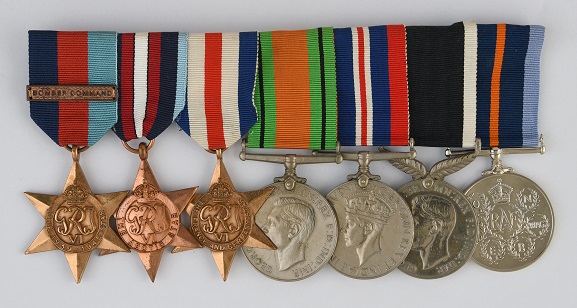
Three standout items in the collection are Frank’s medal group, which includes the Artic Star awarded for serving on the Arctic Convoys north of the Arctic Circle (the only example of this medal in the Air Force Museum collection), the brown leather toy dog that went with him on flights as a good luck charm, and his Navigator’s log book which notably features an entry on the Tirpitz raid.
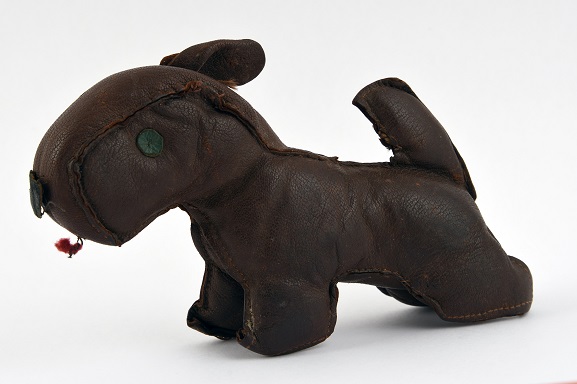
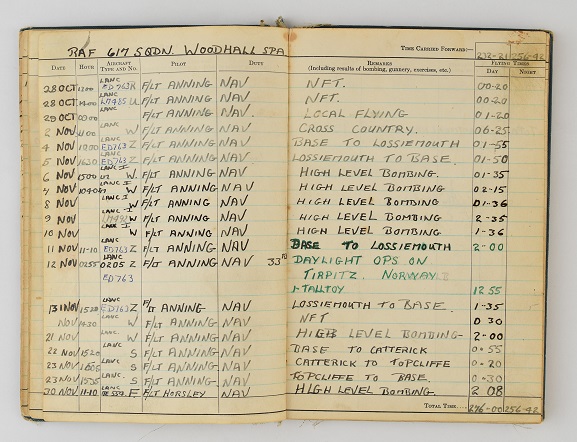
After returning to New Zealand in July 1945, Frank remained connected to Bomber Command, with a long involvement in groups such as No. 44 Squadron and No. 617 Squadron Associations. He passed away in 2014, aged 94.
